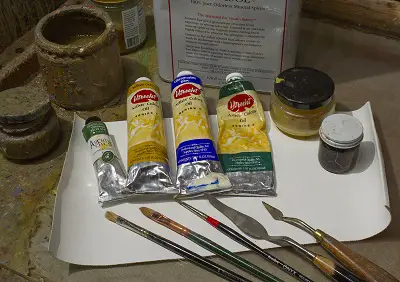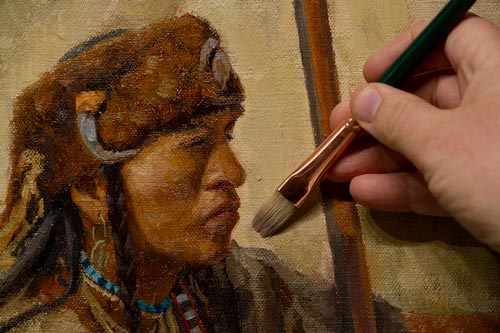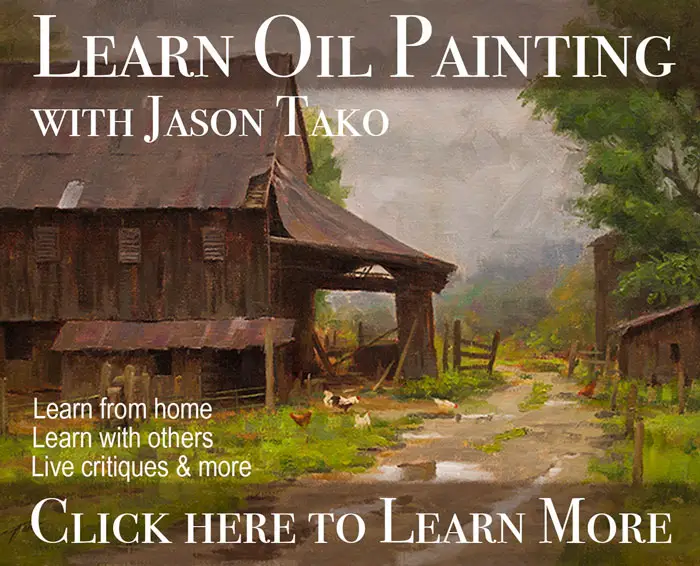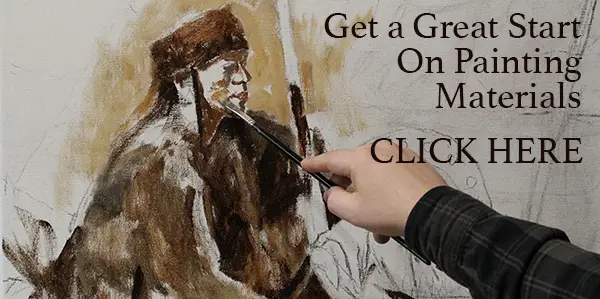
Oil Painting Start-Up Costs and What You Actually Need
If you are just starting oil painting the numerous options can be quite intimidating, and you may wonder how much it will cost. Let's discuss at some oil painting start-up costs and what you actually need to get started oil painting.
The cost to start oil painting can vary depending on the number of colors you buy, the quality of your supplies, and who the vendor is. An average minimum cost to start can be approximately $170. This cost reflects buying only the 3 primaries and white, along with minimal painting accessories.
Let's now discuss the variables involved and what materials you actually need to start oil painting. You can see a list of most of these materials and links on where to obtain them on the Resources Page.
What Oil Colors You Need to Start Oil Painting
Many beginning artists make the mistake of thinking they need a lot of colors in order to do an oil painting. I even know one artist who went to an art store and bought every single pigment available when he started. The truth is you only need a few colors to do a good painting.
At one point, I restricted myself to just the three primaries and white and painted that way for a couple of years. I was able to get almost any color or value that I needed, including black.
The real advantage of having a greater number of pigments is mostly convenience and obtaining rare intensities that one can usually get by without. While you may not be comfortable painting with just three colors and white, it's a great way to learn how to mix color.
Below are a couple of tables where I show the minimum palette needed and my typical expanded palette. I used current pricing (May of 2020) for Utrecht brand oil colors.
Minimum Primary Palette
| Titanium White 120 ML (you will use a lot of white) | $18.44 |
| Cadmium Yellow Light 40 ML | $17.03 |
| Cadmium Red (Medium) 40 ML | $19.50 |
| Ultramarine Blue 40 ML | $7.42 |
Expanded Palette
| Cadmium Orange 40 ML | $17.03 |
| Yellow Ochre 40 ML | $7.82 |
| Burnt Sienna 40 ML | $7.42 |
| Alizarin Crimson (or Alizarin Permanent) 40 ML | $17.03 |
| Cerulean Blue Hue 40 ML | $8.36 |
| Veridian 40 ML | $17.03 |
| Permanent Green (Light or Yellow) | $8.36 |
There are cheaper brands out there, such as Windsor Newton's Winton, Chroma Archival, and Charvin. But my experience with these colors is they are either too stiff, too soft, or just bad consistency. I use Utrecht colors to this day, as do many professional artists. They don't cost much more than lower-grade paints and their quality is superior. Cheap paints usually result in a bad painting experience.
Also, there are way more colors/pigments than what I have listed. This is the main palette I have settled on after over 15 years of painting. Don't be afraid to experiment once you've gotten more comfortable. Just know this, there is no magic color that will solve all your problems. At the end of the day, it's how well you mix the colors you have, not how many colors you have.

What Brushes You Need to Start Oil Painting
This is another area where going cheap it not worth it. You would be way better off buying just a few good quality brushes than buying a bunch of low-grade brushes. Cheap brushes will lose hair faster than my scalp. You will end up with hair in your paint, on your canvas and if the brush is cheap enough, it may not last even one day of average painting. Bad brushes alone may discourage you from painting.
There are a lot of brushes on the market, some good, some horrible. While you usually get what you pay for there good brushes available at a reasonable cost. A great brand is Silver Brush Grand Prix.
For oil painting, I use mostly flat bristle brushes and I can do almost an entire painting with just three different sizes. Below I have a list of brushes that can get you started (prices may vary). While you can get away with just one of each, I recommend two of each. You can use one for dark paint and another for clean, colorful paint.
| Silver Brush Grand Prix Flat Bristle #2 | $5.72 |
| Silver Brush Grand Prix Flat Bristle #4 | $6.44 |
| Silver Brush Grand Prix Flat Bristle #6 | $8.30 |
| Silver Brush Grand Prix Round Bristle #1 | $5.19 |
Once you have a few paintings under your belt, you will want to experiment as there are other types of brushes such as brights, rounds, and filberts, along with different types of hair like synthetics and sables, and different sizes.

Palette Knives for Starters
Palette knives are a great way to mix paint, transfer it, or remove it from a surface. There are metal palette ones and plastic ones with different shapes and sizes. Of course, the metal ones are usually higher quality and more expensive, but for starting out you can buy a set of plastic ones for just around $10. See Resources Page.
Mediums for Cleaning and Thinning
You will need something to clean your brushes while painting, especially if you are using the same brush and going from a dark color to a light color. You will also need something if you want to thin the consistency of your paint.
Odorless mineral spirits can do both. You can get cheap mineral spirits from the hardware store for probably around $10-$12. I use this type of mineral spirits but only when painting outside. This type is not really odorless, even though it says that. In fact, it can have a very strong odor. If you want to get true odorless mineral spirits then Gamsol by Gamblin for around $15 for a 33.8 oz bottle is the way to go. See Resources Page.
If you have an issue with using solvents such as mineral spirits, you can clean your brushes with linseed oil. This is actually how I clean my brushes while painting (I use Murphy Oil Soap to clean them when I'm done painting). A word of caution: linseed oil can spontaneously combust when it's soaked in rags or paper towels. Use a metal garbage can and lid to dispose of. After 10 years I've never had this happen, but I'm not taking any chances.
Canvas for Beginning Oil Painting
There are a number of different canvases on the market. Some are universal-primed, which means they can accept oil or acrylic, and there is oil-primed which can only accept oil paint. There is also cotton duct and linen, not to mention the different grades of roughness or smoothness. Rougher textures tend to be used for landscapes, while smoother textures for portraits.
For starting out you don't need to concern yourself with all these variables, though you will want to learn them if you get serious. An economical way to start is to buy some canvas sheets that come in a pad. It's an actual canvas that you can tear out of a pad like a sheet of paper. You can tape this sheet of canvas onto a piece of plywood, hardboard, or even thick cardboard. Fredrix canvas pads are around $7 for 10 9x12 inch sheets.
I would recommend starting small, 8x10 going up to 12x16 inches until you get more comfortable. See Resources Page.

Good Starter Easel
An easel is not completely necessary. As long as you can find a place to set up your canvas and keep it fairly steady, you are good. Some people will even lay their canvas flat on a table and paint. But if you want to have an easel, you can pick up a compact table-top easel for under $20. This can get you by until you are ready to purchase a big easel. See Resources Page.
Palettes for Starting Oil Painting
There are palettes that you can hold, and there are palettes you don't hold. My preference is to have a palette I don't hold so that both hands are free. My current palette is an old office desk with a piece of glass cut to fit on top. A glass palette is nice for oil painting as it can be easily cleaned with denatured alcohol.
But for starters, you can pick up some paper palettes for less than $10. These are sheets of paper that you tear off and squeeze your paint right onto. While they may only last for a day or so, they can get you by on the cheap until you are ready to move up.
Other Items You Will Need
I didn't include these items in the total price because you probably already have these laying around the house. These include:
- Paper Towels for cleaning your brushes, palette knives and surfaces.
- A plastic or glass jar with a cover for putting your mineral spirits or linseed into to clean your brushes.
- A place to paint with good lighting. Cool lights work best. You can also paint in front of a north-facing window that doesn't ever get direct sunlight (in the Northern Hemisphere).
- A place to store your wet paintings until they dry.
- For storing leftover oil paint, see my article: A Quick and Easy Way to Store Your Oil Paint.
Artists tend to be very creative, and there are many variables and other possible solutions to the ones I mentioned above. My hope is that this list will get you started and help you eventually find your own way and methods. I would love to hear your ideas below or any questions you may have.
Keep Painting!
Jason Tako is a nationally known fine artist who specializes in western, wildlife, plein air, and Historical Native American subject matter. He spent his learning years sketching the wetlands and wooded areas of rural Minnesota. He has been featured in Plein Air Magazine and Western Art Collector Magazine and he was the Featured Artist for the 2020 Southeastern Wildlife Expo. See his work at www.JasonTako.com and his demonstrations on his YouTube Channel.
Warning: Undefined array key "preview" in /home3/mysketc2/public_html/wp-content/plugins/oxygen/component-framework/components/classes/comment-form.class.php on line 75



Warning: Undefined array key "preview" in /home3/mysketc2/public_html/wp-content/plugins/oxygen/component-framework/components/classes/comment-form.class.php on line 79